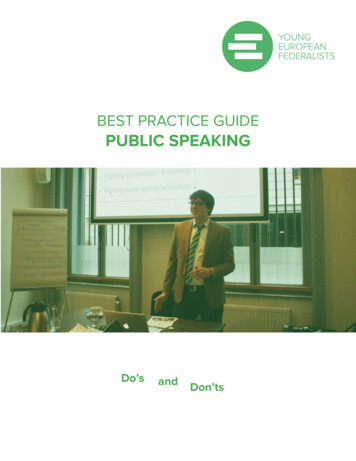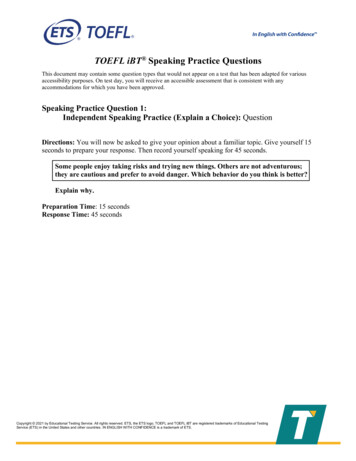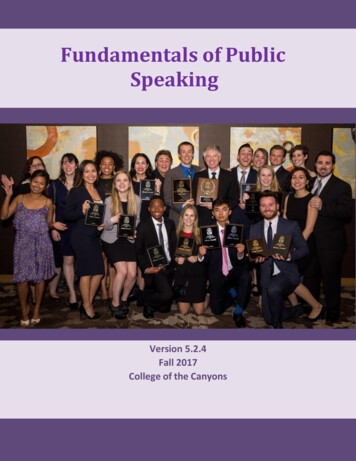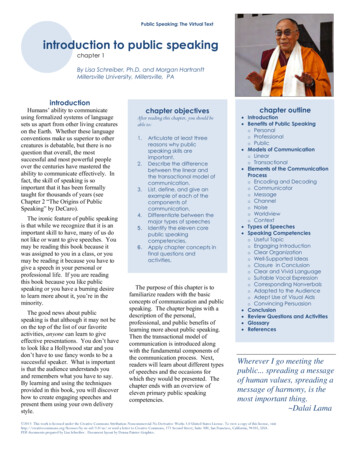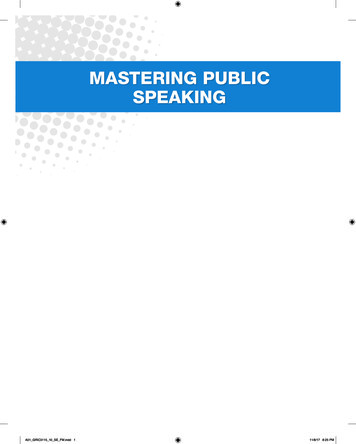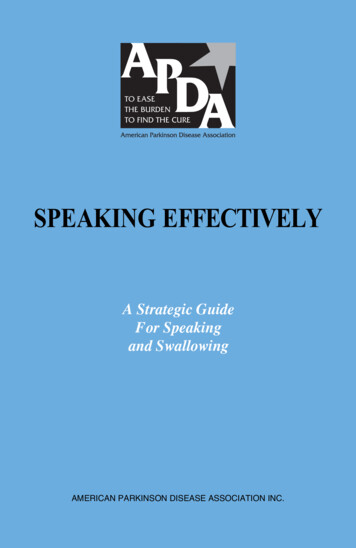
Transcription
SPEAKING EFFECTIVELYA Strategic GuideFor Speakingand SwallowingAMERICAN PARKINSON DISEASE ASSOCIATION INC.
SPEAKING EFFECTIVELYA Strategic GuideforSpeakingandSwallowingBari Hoffman Ruddy, PhD, CCC-SLPAssociate ProfessorDepartment of Communication Sciences and DisordersUniversity of Central Florida, Orlando, Fla.DirectorThe Ear, Nose, Throat and Plastic Surgery Associates Voice Care Center,Orlando, Fla.Christine Sapienza, PhD, CCC-SLPProfessor and ChairDepartment of Speech, Language, and Hearing SciencesUniversity of Florida, Gainesville, Fla.Movement Disorders Clinic, University of Florida,Gainesville, Fla.Research Career Scientist – Brain Rehabilitation Research CenterMalcom Randall VA, Gainesville, Florida American Parkinson Disease Association, Inc.Copyright February 2003
INDEXPART 1:Introduction .1Neurological Basis for Voice and Speech Difficulty.1PART 2:The Role of the SLP in Evaluating and Treating PD.3Where Can I Find an SLP? .3Evaluating Speech and Voice.3PART 3:What is Normal? .5Normal Breathing .5Normal Voice .5Voice Quality .5Voice Handicap Index .6Caregivers Questionnaire.8PART 4:Voice Loudness .9Voice Amplifiers .10Insurance Coverage for Amplifiers .11Programs to Help Improve Voice Loudness .13PART 5:Vocal Pitch .15Pitch Variation .15Biofeedback for Improving Voice Production.15PART 6:Enhancing Speech .17Slow and Even Speech Rate .17Precise and Clear Speech Sounds .17Clear Speech Exercises .17PART 7:Swallowing Function .19What is a Swallowing Evaluation? .20Swallowing Food and Liquids.21Nutritional Risk Factors.22Nutritional Suggestions .22Drooling .22PART 8:Hearing . .24Types of Hearing Aids .25PART 9:Body Language .26PART 10:Medication Effects on Speech and Voice.27Helpful Strategies .27PART 11:AppendicesA. Voice Strategies: A Home Practice Routine .28B. Exercises for Speech Practice .29Words and Functional Phrases.29Functional Sentences .30Paragraphs .31C. Lip Movements .32D. Tongue Movements.32PART 12:Text References .33PART 13:Parkinson’s Website .34General Information.34Treatment .34Diet and Exercise.34Specific Conditions/Aspects .34
INTRODUCTIONChanges in the ability to communicate may often occur in people who haveParkinson’s disease (PD). These changes may result in social isolation and socialwithdrawal. Some individuals have described “the speech and voice difficulty asthe most debilitating of their Parkinson’s symptoms leaving them unable to effectively communicate, and in some cases, limiting employment opportunities.” Thisbooklet is intended to provide persons with PD, spouses, other family members,care providers, and friends with information on speech, voice and swallowingfunction related to PD. Information about the signs, symptoms, evaluation and thetreatment process are discussed. Strategies or tools that are needed to effectivelycommunicate in daily living activities are also included. Another purpose of thisbooklet is to emphasize and encourage persons with PD to seek early interventionfor their speech, voice or swallowing difficulties from a certified speech-languagepathologist, as restorative treatment options are available.Sometimes the changes that occur in the voice, speech, and swallow system are thevery first symptoms of the disease. In other individuals, these changes graduallyappear as PD progresses. In many instances, the changes are subtle and oftenundetected by the individual with PD. But, just as a spouse or friend may be thefirst to notice reduced arm swing or altered gait, the same may be true for thechanges that occur in speech and voice.Some of the same physical symptoms that occur in the limbs (tremor, bradykinesia/reduced movement, and rigidity) can also occur in the speech, voice and swallowing systems. These changes are often referred to as a dysarthria. Dysarthria isa collective term used to refer to the impaired production of speech due to disturbances in the muscular control of the speech production and swallowing mechanism. Hypokinetic dysarthria is the term used to refer to the specific type ofdysarthria we know as PD (a.k.a. Parkinson’s dysarthria). The term “Hypokinetic”means reduced movement. Therefore, hypokinetic dysarthria is reduced movement of the muscles used for voice production and swallowing.Neurological Basis For Voice And Speech DifficultyIn general, PD is a slowly progressive neurological movement disorder caused bya degeneration of dopamine producing cells in the substantia nigra. The effects ofPD can affect respiration (breathing), phonation (voice production), resonation(richness of voice), articulation (clarity of speech), and swallowing function.Disruptions to breathing, voice, speech and swallowing characteristics are causedby impaired movements of muscles, which are slower, less accurate, weaker or difficult to coordinate with other movements. The muscles of the lips, tongue, throat,larynx (voice box) and lungs may all be affected. The primary result of thesechanges in muscle performance includes imprecise articulation and rapid speechrate with progressive acceleration and short rushes of speech, reduced stress of syllables, reduced loudness, a hoarse, tremulous, monotone voice, impaired tonguemovements, weak pharyngeal wall movements and/or difficulty directing foodinto the esophagus/stomach tube.1
Practical suggestions for ways to improve eating ease and swallow safety are alsoincluded in this booklet. Excessive saliva production, drooling and hearingimpairment are concerns for many people with PD. These problems also have aneffect on communication. Practical ways of dealing with them are reviewed.2
THE ROLE OF THE SLP IN EVALUATING AND TREATING PDThere are many professionals that care for the person with PD. Speech-languagepathologists (SLP) are healthcare professionals trained to evaluate and treatindividuals with speech, voice, language, and swallowing problems. A SLP has agraduate degree and is certified by the American Speech-Language and HearingAssociation (ASHA).Developing and improving effective communication skills and swallowing function are the primary roles of a SLP when treating an individual with PD. ManySLP’s have specialized training, specifically in treatment of the PD population.Where Can I Find an SLP?Local hospitals and rehabilitation centers employ SLP’s to provide both inpatientand outpatient services. In addition, many SLP’s have private practices, and manyuniversity clinics specialize in treatment of PD.ASHA may also help locate SLP’s in specific geographic regions. ASHA can becontacted at:American Speech-Language and Hearing Association (www.asha.org)10801 Rockville PikeRockville, Maryland 20852Phone: (800) 498-2071Fax: (301) 296-8580TTY: (301) 296-5650Email: actioncenter@asha.orgAlso the Ellis Neurological Voice Treatment Foundation is dedicated to the education, research and training of SLP’s in the treatment of neurological speech andvoice disorders. This foundation maintains a roster of certified SLP’s specificallytrained in the Lee Silverman Voice Treatment for PD. Contact information is:Ellis Neurological Voice Treatment FoundationP.O. Box 642Louisville, Colorado 80027Phone: (303) 604-3280Evaluating Speech and VoiceHealthy speech, voice, and swallowing production require that the brain andmuscles that work the structures of the head, neck and pulmonary system are allfunctional. If a referral to a SLP is made, it is most likely that he/she will beworking closely with an otolaryngologist (a physician who diagnosesdisorders of the ear, nose and throat) or a neurologist (a physician who diagnosesand treats disorders of the nervous system). The SLP’s job is to determine if thereare problems with the way the structures in the oral cavity (tongue, lips, jaw etc)3
are working to produce speech, voice and swallow. Questions about medical history will be asked and specific questions about the changes in speech, voice, ed. Particular emphasis will be on how speech and voice quality haschanged and what circumstances or situations make it get better or worse.Questions about changes to eating and nutrition will also be asked.A SLP may perform an oral peripheral examination, to look at the structure andfunction of the lips, tongue, jaw and other parts within the mouth. Following theoral peripheral examination, the speech pathologist may perform an examinationof the vocal cords. This is done in the physician’s office and allows the medicalteam to determine if the vocal cords are moving normally.The SLP is the person who will provide detailed information about the changesthat will occur in speech, voice and swallowing as the disease progresses and willbe able to offer solutions and treatment for improving speech, voice andswallowing if problems are being experienced.4
WHAT IS NORMAL?Normal BreathingIn order to breathe without effort the lungs, muscles of the ribcage, diaphragm andabdominal muscle all need to be healthy and function normally. Each of these partsmakes up a big portion of the respiratory system. When air is taken into the lungsit is called primary inspiration or inhalation. To breathe-in, the lungs have toexpand in volume. Movement of the diaphragm achieves this. When air is movedout of the lungs it is called expiration or exhalation. To breathe-out the lungs haveto decrease in volume. Movement of the abdomen and the ribcage achieves this.When all parts of the respiratory system are functioning normally, the effort tobreathe is minimal and automatic. When problems arise, the effort of breathingincreases and this is when a physician should be consulted immediately.Normal Voice ProductionRespiration (breath support) is often referred to as the “power-source” for voiceproduction. When speaking, air must be brought into the lungs (inhalation).During exhalation, the air rushes through the vocal cords. The vocal cords sit rightat the top of the windpipe, therefore, when air rushes out of the lungs it movesthrough the vocal cords. When speaking, the vocal cords move close together. Theair rushing through the vocal cords causes the vocal cords to vibrate generatingsounds. Depending on age and sex, the vocal cords will vibrate from 100 to 250times per second. Articulators (tongue, lips, teeth) move in specific patterns toshape the sound generated from the vocal cords into speech sounds. The brain isresponsible for sending a message by way of a nerve to the vocal cords to be in theappropriate position to vibrate when the air rushes though them during exhalation.If there is damage to the brain, or changes in the way it functions then thismessage may not be sent, resulting in a change in vocal quality. The nerve thatsupplies the information to the vocal cords regarding their position may bedamaged as well.Voice QualityAs a result of PD voice quality may sound hoarse, breathy or low in loudness. Thisis caused by the vocal cords in the larynx/throat not firmly meeting in a regularrhythm or closing pattern when the voice is produced. Below are two checklists(Hogikyan & Sethuraman, 1999; Hogikyan & Rosen, 2002, Jacobsen, Johnson,Grywalski, Silbergleit, Jacobsen & Benninger, 1997) that can be used to determineif changes in the voice are presenting a handicapping condition.5
Voice Handicap Index: This index was developed for patients that experiencedifficulty with their voice. Sometimes the problems can become severe enoughthat it imposes a handicapping condition. The Voice Handicap Index can be usedas a way to see if voice problems associated with PD are adversely affecting dailyactivities.Instructions: These are statements that many people have used to describe theirvoices and the effects of their voices on their lives. Circle the response thatindicates how frequently you have the same experience.0 Never 1 Almost Never 2 Sometimes 3 Almost Always 4 AlwaysPart I-Functional1.My voice makes it difficult for people to hear me.012342.People have difficulty understanding me in a noisy room.012343.My family has difficulty hearing me when I call them throughout the house.012344.I use the phone less often than I would like to.012345.I tend to avoid groups of people because of my voice.012346.I speak with friends, neighbors, or relatives less often because of my voice.012347.People ask me to repeat myself when speaking face-to-face.012348.My voice difficulties restrict personal and social life.012349.I feel left out of conversations because of my voice.0123410.My voice problem causes me to lose income.01234Part II-Physical1.I run out of air when I talk.012346
2.The sound of my voice varies throughout the day.012343.People ask, “What is wrong with your voice?”012344.My voice sounds creaky and dry.012345.I feel as though I have to strain to produce voice.012346.The clarity of my voice is unpredictable.012347.I try to change my voice to sound different.012348.I use a great deal of effort to speak.012349.My voice sounds worse in the evening.010.1234My voice “gives out” on me in the middle of speaking.01234Part III-Emotional1.I am tense when talking to others because of my voice.012342.People seem irritated with my voice012343.I find that other people don’t understand my voice problem.012344.My voice problem upsets me.012345.I am less outgoing because of my voice problem.012346.My voice makes me feel handicapped.012347
7.I feel annoyed when people ask me to repeat.012348.I feel embarrassed when people ask me to repeat012349.My voice makes me feel incompetent.0123410.I am ashamed of my voice problem.01234Often it is the caregiver who realizes the change in communication before theperson with PD. A care partner, family member or friend who has regular contactcan help complete the form below. The respondent should carefully read eachstatement, thoughtfully consider if it applies, and make a check mark if it does:Caregiver Questionnaire1.2.3.4.5.6.7.8.9.I have difficulty hearing my Parkinson partner when he/she speaks.I have difficulty understanding his/her speech.My Parkinson partner does not talk as much as in the past.My Parkinson partner does not attend social functions as frequently asin the past.He/she often asks me to make phone calls or order from a menu forhim/her.My Parkinson partner clears his/her throat often.My Parkinson partner often sounds as if he/she is running out of breathwhen speaking.My Parkinson partner suspects that I need a hearing aid.My Parkinson partner thinks I ignore what he/she has to say.Multiple “yes” answers, or a “yes” answer to even one issue could interfere withdaily communication. This may be sufficient to request referral for a completespeech and voice evaluation because the difficulties that are being experiencedmay have an underlying medical cause.Try these suggestions to improve voice quality:q Try to produce a staccato or sharp sound while producing voice.q Keep the loudness level of the voice up by pushing air from theabdomen.q Practice speech drills and lip and tongue strengthening exercises (seeAppendices)q Protect the vocal cords by avoiding excessive coughing, throat clearingor yelling.q Protect the vocal cords by keeping the home air moist. Use ahumidifier, if necessary8
VOCAL LOUDNESSThere are many aspects of speech or voice that can be affected because of PD.Low vocal loudness level means that the vocal output is softer than normal. Oftentime persons with PD indicate that they cannot be heard or that they have a hardtime speaking over crowd noise like that, which occurs at a social gathering. Also,family members or a spouse may complain that the person with PD is not speaking up loud enough and it can lead to frustration during communication interaction. The difficulties that persons with PD have with vocal loudness have beenwell studied. Some believe that it results because of the changes that occur to themuscles that help the voice get loud, like the muscles of the vocal cords or themuscles that control breathing. Others believe that the person with PD needs to betrained how to speak louder and that with adequate training using a louder voicecan be achieved. The training programs that are used to help persons with PD willbe discussed later in this section.There are some strategies that can be used to increase the loudness level ofthe voice such as:q Take a big breath before beginning to speak. This helps give enough airto speak on and will actually make the voice come out louder. Start bytrying to hear the voice as soon as the breath is allowed to exhale. Beginby breathing in and then slowly exhaling. Try to control the air that isreleased when you exhale (slow and controlled). Next, say the vowels“ah” or “ee” with the lips slightly parted on a steady flow of exhaled air.Try to hold the sound for at least 15-20 seconds or make that an eventual goal as the practice continues. This can be done three times in a rowwith a 1-2 minute rest after each of the three sound productions. Thisshould be done 3-4 times a day to help gain control of the breathing anddevelop an awareness of how speech is produced.q Make sure that the sentences/phrases that are spoken are not too long.The longer the phrase the more air that is used. If the amount of air runsout then it will require more physical effort to keep the voice loud. Aphrase like: “The other day I went to the store” would be a phrase ofadequate length. After finishing the phrase, another breath needs to betaken, if not it will be very difficult to make the voice stay loud.q It can help if muscles in the abdomen are used to help force air out thelungs. This is especially true when the voice is used to yell or talk veryloud over crowd noise. Try speaking aloud a short staccato countingphrase “hut, 2,3,4.” Keep a hand on the abdomen and feel the in- andout- movement of the abdominal wall.q Maintain a good posture. It is most efficient if the body and head arefacing straight. If the head is tilted to one side or the posture is slouchedit does not allow the muscles that are working together to produce speechto be in an optimal position.q Open the mouth when speaking. If the mouth (jaw and lips) are notmoving very much during speaking it actually makes the sound come out9
less loud. Try at first to over exaggerate lip and mouth movements whensaying vowels such as “ah” or the words found in Appendix C. Hear andfeel the difference when the mouth is open wide compared to trying tospeak through nearly closed lips.If it is still difficult to make the voice loud after trying some or all of theseexercises, then there could be some other reasons that are preventing progress.First, discuss these difficulties that are being experienced with a neurologistand/or speech pathologist. They may make a referral to other specialists todetermine if:The vocal cords are weak and unable to close properly. A consult with anEar, Nose and Throat doctor (otolaryngologist) may be made to examinethe function of the vocal cords.The lungs are not functioning normally. A consult with a pulmonologistmay be made to test the function of the lungs.See Appendix B for some functional phrases and sentences to use at home topractice projecting vocal loudness.Voice AmplifiersThere are some circumstances where the voice needs additional help in beingmade loud. These circumstances include work environments that are noisy andrequire the voice to be loud for long periods of time. With PD the voice will tireover time and even the strategies listed above may not be enough to keep the voiceloud. In these situations augmentative devices can be used to give the voice thatextra power it needs. These devices are called amplification units or voice amplifiers. The amplifiers can be personal amplifiers worn on the body or placed in aroom, such as classroom or conference room. Sometimes the microphone is wornon the lapel of a shirt or is part of a headset system. Remember the amplifiers willnot improve the quality of the voice, it will simply make it louder. Most of thedevices on the market can at least double the loudness level of the voice. A speechpathologist and family members can help decide which type is the best device forthe situation. Additionally, the amplifier should be comfortable to the person withPD. The following list is a sample of companies that market voice amplificationsystems, which might be useful in providing compact personal amplificationsystems for people with low-volume speech.q Luminaud, Inc.8688 Tyler Blvd.Mentor, Ohio 44060800-255-3408440-255-9082FAX 440-255-2250Email: info@luminad.comq Communicative Medical, Inc.PO Box 8241Spokane, WA 99203- 0241800-944-6801Fax: 360-546-384110
q One to One Communications15738W 148th TerraceOlathe, Kansas 66062913-764-4072q Park Surgical Company5001 New Utrecht AvenueBrooklyn, NY 11219718-436-9200q Lauder Enterprises, Inc.4754 Shavano OakSuite 104PO Box 78249San Antonio, TX 78249-0427210-492-0864q Phonic Ear, Inc.20809 Lakeville HighwayPetaluma, CA 94954707-769-1110q Phone Merchants929 West Pike StreetClarksburg, WV 26301877-291-1076q Professional Speech Aid Service30 Salem MarketplaceSalem, CT 064201-800-454-7778q Anchor Audio, Inc.5931 Darwin CourtCarlsbad, CA 920081-800-262-4671q ZYGO Industries, Inc.PO Box 1008Portland OR 97207-10081-800-234-6006q Crestwood CommunicationAids, Inc.PO Box 091007Milwaukee, WI 53209414-351-0311Insurance coverage for amplifiers: MEDICARE does not usually cover amplifiers,but they are considered on an individual basis and some people have beenreimbursed, so it may be worthwhile to submit a claim.Here are some other suggestions that can be used to enhance communication.1. Choose the best spot to communicate. Areas with appropriate lightingand very little noise are the best;2. Look for visual cues to determine what the communication partner istrying to get across;3. Ask for written words if needed to get on the same topic;4. Provide feedback to the communication partner that the message hasbeen understood or that a part of the message has not been understood;5. Do not pretend that you understand;6. Try not to interrupt the person who is talking with you;7. Avoid putting objects in front of the face while speaking;8. Avoid having objects in the mouth (i.e. gum, cigarettes, and food) whilespeaking;9. Use gestures;10. Provide clues to the communication partner when a subject changes;11. Rephrase what is being said if the message is not being understood.11
There are other types of devices that are used when a person’s ability to communicate becomes very limited. These are also called augmentative or assistivedevices. The devices can be used in addition to continued efforts at speechimprovement or by themselves. Some systems are quite simple and inexpensive,while others are complex and more expensive.Writing - This is most common way to communicate without speech.Keep writing materials accessible at all times. These could include paperand pencil, clipboard, small chalkboard with chalk and eraser or a magicslate (found in toy departments). When writing or printing, concentrate onkeeping the letters large and well spaced.Pointing Systems - This includes such items as a large board, notebook,binder or photo album with pictures of family, friends and commonly useditems. Alphabet boards or notebooks with words for frequently neededitems organized into categories are other helpful pointing systems.Electronic/Computer Systems - These are the most sophisticated systemsand may consist of a keyboard, display screen and printer. Many areportable. Size of keyboard and display/printer variesBefore purchasing a device, consult with a speech-language pathologist. Thefollowing companies are some of those marketing communication devices.Crestwood LLCP.O. Box 090107Milwaukee, WI 53204Pointer Systems, Inc.One Mill StreetBurlington, VT mhttp://www.pointersystems.netTradeMark Medical449 Soveeign CourtBaldwin, MO 63026646-527-2288Words 42505 10th St. WestLancaster, CA tp://www.words-plus.comMayer-Johnson Company2100 Wharton Street STE 400Pittsburgh, PA 15203412-381-4883Communication Skill Builders555 Academic CourtSan Antonio, TX p://www.psychcorp.comAttainment CompanyP.O. Box 930160Verona, WI 53593-0160Dynavox Systems Mayer-Johnson2100 Wharton Street, Suite 400Pittsburgh, PA oxsys.com12
ZYGO Industries, Inc.P.O. Box 1008Portland, OR 8 Bellevue TerracePittsburgh, PA .comACCI280-B Moon Clinton RoadDept 96-IMoon Township, PA 15108800-982-2248Prentke RMCH Company1022 Heyl RoadWooster, OH .comPrograms To Help Improve Voice LoudnessOne of the most widely used programs that has been tested and shown to havepositive outcomes for persons with PD is called the “The Lee Silverman VoiceTreatment” (LSVT) program. Lorraine O. Ramig, Ph.D., CCC-SLP, and CarolynMead, M.A., CCC-SLP developed this program, in 1987. Both are speechpathologists. It was named after one of the first patients to receive this treatment.It is an intensive behavioral treatment program that requires a person with PD toengage in 16 therapy sessions in one month. The major goal of the technique is tohelp improve vocal loudness, but as a result of the therapy, improvements inspeech clarity and breathing often result. While the number of sessions to becompleted in one month is very intensive the outcomes of the program is long lasting (Ramig, Sapir, Countryman, Pawlas, Obrien, Hoehn, Thompson, 2001). Moreinformation on the program can be found at www.lsvtglobal.comThe LSVT program consists of five essential concepts:Concept 1: focuses on the VOICE. This concept works on helping the vocal cordsclose better, reinforces the idea of “THINKING LOUD/THINKING SHOUT” andattempts to train the speech to be as clear as possible.Concept 2: focuses on HIGH EFFORT with emphasis on vocal and physicaleffort. This focus on effort is thought to override the muscles lack of movementandslowness of movement to new effort levels particularly as the disease progresses.The clinician helps the person with PD scale the effort needed to perform the tasksduring therapy.Concept 3: sixteen sessions are done on an individual basis for a period of onemonth. This provides daily opportunity to practice and over the 16 sessions,allows the degree of vocal effort to be increased. It helps maintain a certain levelof motivation and accountability. It also provides adequate time for the skill(s)to be learned and transferred to other environments such as home or work.Finally it allows the SLP to document any fluctuations in the patient’s perform13
ance.Concept 4: focuses on defining what the patient “knows” and “accepts” about theamount of effor
American Speech-Language and Hearing Association (www.asha.org) 10801 Rockville Pike Rockville, Maryland 20852 Phone: (800) 498-2071 Fax: (301) 296-8580 TTY: (301) 296-5650 Email: actioncenter@asha.org Also the Ellis Neurolo


